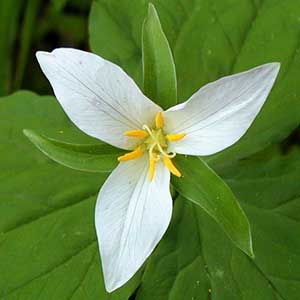Trillium ovatum
Trillium undulatum
Pacific trillium, trillium, western trillium, western wake-robin, western white trillium, white or western trillium, white trillium
painted lady, painted trillium, painted wakerobin, trille ondulé
semierect to horizontal, short, stout, praemorse.
horizontal, short, stout, ± praemorse.
1–2, round, 2–5 dm, ± slender, glabrous.
1–3, dark greenish maroon, round in cross section, 1.1–4 dm, glabrous.
sessile, subsessile, or short-petiolate;
blade medium green, sometimes blotched and mottled, main veins prominent, ovate-rhombic, 7–12 × 5–20 cm, continuing to expand during anthesis, base rounded, apex acuminate.
strongly petiolate;
blade dark green over maroon, main veins prominent, ovate to long-acuminate, 12–18 × 8–20 cm, ± glossy, base above petiole rounded, apex acuminate;
petiole 4–17 mm.
erect or nodding, odorless;
sepals spreading to horizontal, green, lanceolate to oblong-lanceolate, 15–50 × 6–20 mm, margins entire, apex acute;
petals erect-ascending, usually wide-spreading from base, exposing entire pistil, white or with pink or blush markings, lacking V-shaped markings, fading to rosy pink, purple, or dark red, veins not deeply engraved, ± linear to widely obovate, 1.5–7 ×1–4 cm, widest at or above middle, thin-textured, margins flat to undulate, apex acuminate;
stamens prominent, slightly recurved-spreading to straight, 10–18 mm;
filaments white, shorter than anthers, slender;
anthers yellow, 4–16 mm, slender, dehiscence latrorse-introrse;
ovary green or white, ovoid, 6-angled, 5–12 mm, attachment ± 3/4 ovary width;
stigmas recurved, barely connate basally, greenish white or white, linear, not lobed adaxially, 6–10 mm, uniformly thin;
pedicel erect to leaning, 2–6 cm.
opening above bracts, erect, odor unknown;
sepals conspicuous, spreading, wine red to dull maroon green, rarely white-striated, lanceolate-acuminate, 13–37 × 4–10 mm, margins entire, apex acuminate;
petals spreading, white, with distinct, inverted, V-shaped, dark-red mark basally, the red radiating outward along major veins, or white and lacking red marks, veins not engraved, oblong-ovate, occasionally lanceolate, usually widest just above middle, 2–5 × 1–2 cm, base tapering very gradually to attachment, margins not undulate basally, undulate apically, apex somewhat rapidly acuminate;
stamens straight, 8–12 mm;
filaments pink or white, equaling or longer than anthers, slender;
anthers erect or slightly spreading, white or pink, 2–7 mm, thin, dehiscence extrorse;
connectives pink, equaling anther sac;
ovary fully exposed, white, pink tipped, obtusely 3-angled, becoming obscurely angled-rotund in cross section, 3–10 mm, broadly attached;
stigmas ascending, barely connate basally, then strongly recurved, white, ± linear, 3–10 mm, uniformly thin;
pedicel erect, 2–5 cm.
baccate, green or white, ± odorless, broadly ovoid, obscurely winged, 1.2–2.8 × 0.7–1.9 cm, pulpy-moist.
quickly deciduous upon ripening, scarlet, obscurely 3-angled to cylindrical, 1–2 cm, fleshy, juicy.
= 10.
= 10.
Trillium ovatum
Trillium undulatum
Varieties 2 (2 in the flora).
(Discussion copyrighted by Flora of North America; reprinted with permission.)
Several forms of Trillium undulatum have been described. One, forma enotatum T. S. Patrick, lacks the usual red, V-shaped petal markings. Other named forms have green petals, extra leaves or petals, and deformities suggesting a mycoplasma infection as in Trillium grandiflorum.
This difficult-to-cultivate species has been reported from Wisconsin, but it cannot be accepted as native there.
(Discussion copyrighted by Flora of North America; reprinted with permission.)
1. Bracts sessile; petals lanceolate to obovate, 1.5–7 × 1–4 cm | var. ovatum |
1. Bracts distinctly short-petiolate; petals linear to linear-lanceolate, 0.5–2.4 × 0.2–0.6 cm | var. oettingeri |
- Local floras:
BC,
CA,
OR,
WA
- Local Web sites:
CalFlora,
CalPhotos,
Flora NW,
PNW Herbaria,
Turner Photog.
WildflowerSearch
iNaturalist (observations)
USDA Plants Database
- LBJ Wildflower Center
- SEINet
- Plants of the World Online
- Encyclopedia of Life
- Wikipedia
- Google Image Search


